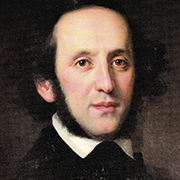In his large-scale work “Lobgesang” (“Hymn of Praise”), Felix Mendelssohn Bartholdy combines words from the Bible, thoughts from Martin Luther and set pieces from earlier compositions to make a rounded and effective choral-symphonic work.
Described by Robert Schumann as “everything that can make people happy and ennoble them,” Felix Mendelssohn Bartholdy’s Lobgesang was regarded throughout the 1840s and beyond as one of his most original compositions, receiving a remarkable twenty-six performances in the seven years between its completion and Mendelssohn’s death. Eventually, however, detractors including A. B. Marx, Richard Wagner, and George Bernard Shaw charged the work with being an unbecomingly derivative imitation of Beethoven’s Ninth Symphony – and while more recent scholars have challenged these anachronistic and often anti-Semitic views on a wide variety of grounds, the complete details of the Lobgesang’s composition, performance history, sources, and musical form have never been fully sorted out.
Until now. Building on the insights of previous editors and scholars, meticulously unraveling the dense web of manuscripts and authorized editions, and availing itself of newly available correspondence, the present edition offers an authoritative text for the Lobgesang and new insights into the work. It is the first modern edition to present the piano-solo version of the opening Sinfonia and the piano accompaniment to the remaining numbers in Mendelssohn’s own arrangements. It is the first to identify the English translator and establish Mendelssohn’s own agency in authorizing the English translation; the first to thoroughly document the work’s genesis; and the first to authoritatively resolve the many issues raised by the work’s magnificent autograph score, the piano-vocal arrangements, and the first edition of the parts and the first edition of the full score – sources that are all authorized by Mendelssohn, but that contradict each other in myriad ways.
The Lobgesang represents a convergence of three initially separate musical conceptions: the Festgesang Möge das Siegeszeichen (MWV E 2; 1838), an unfinished Symphony in B-flat major (MWV N 17; 1838-39); and “a larger Psalm” written for the city of Leipzig’s celebration of the quadricentennial of Gutenberg’s invention of the printing press. Work on the first version progressed quickly, and the Lobgesang’s premiere under Mendelssohn’s baton in the Leipzig Thomaskirche in June 1840 created a sensation – as did its first English performance at the Birmingham Festival in September 1840. But Mendelssohn’s characteristic self-criticism had led him to become dissatisfied with the work, and between then and 16 December 1840 he introduced several important expansions. He performed the work in revised form in a special performance that included King Friedrich August II of Saxony and his retinue in the audience. That performance resulted in the Saxon monarch’s coming up onto the stage to congratulate the composer – much to the joy of audience, performers, and composer alike – and in the work’s full score being dedicated to him when it finally appeared in September 1841.
In addition to the fundamental chronological and philological matters mentioned above, the present edition is also the first to explain the significance of the motto by Martin Luther that the composer requested be presented at the head of the score, but that has been omitted from all modern editions. And, perhaps most importantly, it is the first to suggest that the reason for the widespread contemporary declarations of the Lobgesang’s originality -- Gustav Schilling, for example, proclaimed it “a completely new form of art” – derived at least as much from its form as from its content. For the evidence shows that Mendelssohn’s symphony-cantata was neither conceived nor understood as a unilinear series of movements modelled on Beethoven’s Ninth Symphony, as its critics would later charge, but rather as a frame story – a parable-like narrative enfolded into a framing symphony-cantata. That embedded narrative constitutes the motivation for the audacious contribution to romantic form that is Mendelssohn’s Lobgesang – and so the Lobgesang, far from being an uninspired imitation of a pre-existing form, emerges as a bold experiment in musical narrative and symbolic musical memory.
John Michael Cooper
(from [t]akte 1/2020 – translation: Elizabeth Robinson)



